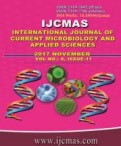


 National Academy of Agricultural Sciences (NAAS)
National Academy of Agricultural Sciences (NAAS)

|
PRINT ISSN : 2319-7692
Online ISSN : 2319-7706 Issues : 12 per year Publisher : Excellent Publishers Email : editorijcmas@gmail.com / submit@ijcmas.com Editor-in-chief: Dr.M.Prakash Index Copernicus ICV 2018: 95.39 NAAS RATING 2020: 5.38 |
The productivity of sugar beet is strongly limited by several biotic stresses, among them rhizomania is one of the important factor causing yield loss of 20–50% or more. Beet necrotic yellow vein virus is the etiological agent of the destructive disease. The BNYVV belongs to the Benyvirus genus and is transmitted by the soil-borne fungus Polymyxabetae. Virus can survive within thick-walled resting spores (cystosori) of P. betae for more than two decades in soil. Root proliferation is the well-known characteristics of the viral infection that leads to yield and sugar losses. No authorized chemical treatment for rhizomania exists. Crop rotation does not appreciably reduce disease risk because of the long-term survival of cystosori. The only effective way to control it is by using a seed variety with resistant genetics. Genetic resistance to BNYVV was initially identified by the Holly Sugar Company in 1983.The dominant gene was coined as the holly gene or Rz1 but it confers partial resistance. Extensive use of sugar beet cultivar showing partial resistance although allows containment of sugar yield, on the other hand it permits the viruliferous vector to be amplified and therefore emergence of resistance breaking isolates. To counter this risk, in the United States SESVander Have has developed Rhizomania resistant varieties based on the “Tandem Technology®”. The hybrid possesses resistance that combines the ‘Holly’ gene with another source of resistance from Beta maritima of which SESVander Have is the sole holder. In addition artificially generated resistance represents an alternative to the natural resistance and generatedhigherprotectionlevelsthanRz1.
 |
 |
 |
 |
 |